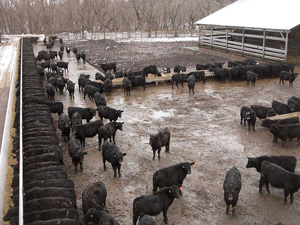Threats to the Land
By Jillian Randel

A Cafo, or concentrated animal feeding operation.
Since large-scale farms of today have replaced the small farms of old, the bucolic nature of farming has given way to more industrialized techniques that may not always be better.
Large-scale farming operations pose a huge threat to the health of America’s waterways. A major source of contamination in drinking water is runoff from fertilizers that contain high levels of nitrates.
Nitrates are essential for plant survival. Because plants deplete the soil of this essential nutrient over time, large agricultural operations must use fertilizers to supplement the soil with nitrogen.
Nitrate overflow can occur when too much fertilizer is applied on fields and the plants cannot absorb it all. The result is a high level of nitrates flowing out of crop fields. As the nitrates get flushed out of the soil, they contaminate groundwater sources.
“Nitrogen contents in water will end up some place, and generally in streams and lakes,” said Dr. Ariel Szogi, research soil scientist at the U.S. Agricultural Research Service.
In a September 2010 report, the U.S. Geological Survey monitored and documented nitrate levels above 10 mg/L—the maximum contaminant level set in the Safe Drinking Water Act—in over 20 percent of shallow household wells in agricultural areas.
Nitrates can severely harm human health. Upon entering the digestive tract, nitrates convert into nitrites, which cause sickness in infants. According to the Environmental Protection Agency, some communities in agricultural areas spend millions of dollars a year treating their water supplies to remove nitrates.
Concentrated animal feeding operations (CAFOs) are another source of nitrogen pollution. CAFOs are small areas where livestock are crammed together in close quarters with limited ability to move around.
The high amounts of urine and manure produced in CAFOs is transported to lagoons that often break or leak, sending dangerous microbes, bacteria and nitrates into nearby water supplies.
According to reports by the National Resources Defense Council, waste lagoons emit toxic gases such as ammonia, hydrogen sulfide and methane. Negative health effects from these gases range from headaches, shortness of breath, wheezing, excessive coughing, diarrhea and sore throat to symptoms as severe as seizures, comas and death.
Many farmers use the manure itself—which contains high levels of nitrogen—as fertilizer. It is a free alternative to industrial fertilizers that can ensure higher crop yields.
The American Farmland Trust started a program called The BMP (Best Management Practice) Challenge to address long-term solutions to excess use of nitrates. Farmers in the program agree to apply less fertilizer to their fields and apply it during a time when plants are expected to absorb the most. If crop yields decrease, the program compensates them for losses.
“Nitrate levels are a major health hazard and need to be checked in groundwater,” said Szogi. “The best thing to do is go to the Department of Health and Human Services or another certified lab and they can test a water sample for a small fee.”
Keeping the Cows out of the River
A gentle cow drinking from a river seems like an idyllic pastoral scene—but that could be one harmful heifer. Cattle and their waste are major threats to open waterways.
“Farmers don’t have the appropriate buffers in place to fence livestock out,” said George Santucci, executive directive of the National Committee for the New River. “It is a huge problem with erosion and E. coli often poses a serious health threat.”
Santucci blames historic farming practices and says it is a challenge and expense to farmers to install appropriate drinking systems that keep cattle from polluting our valuable water sources.
If your water tests above 10mg/L for nitrates, you will need to have it treated for nitrate poisoning. If you are unsure of how to get your water tested, interpret lab results or report results, contact your local health department.
For more information, visit water.epa.gov/drink/contaminants/basicinformation/nitrate.cfm.
Related Articles
Latest News

Leave a comment
Your email address will not be published. Required fields are marked *




